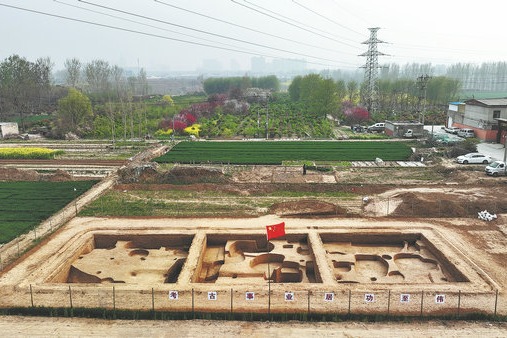Yinxu slowly reveals its secrets
More complete picture of ancient capital emerges as archaeologists unearth detailed road network, Wang Ru reports.
Almost a century after excavations began at the Yinxu Ruins in Anyang, Henan province, new findings continue to refresh understanding of this remarkable page in Chinese history.
In its latest announcement about discoveries at the late Shang Dynasty (c. 16th century-11th century BC) capital site, the National Cultural Heritage Administration said that archaeologists have found a road system with at least three east-west and three north-south roads on the northern bank of the Huanhe River (now known as the Anyang River), among which is a north-south road believed to have been a traffic artery.
Spread across the north and south banks of the Huanhe River in the suburbs of Anyang, Yinxu covers about 30 square kilometers.
Niu Shishan, a researcher at the Institute of Archaeology at the Chinese Academy of Social Sciences, who is leading the team at the Yinxu Ruins, says they have found multiple road ditches (where roads have sunk with vegetation now growing on them) and other ditches in recent years.
The longest road ditch stretches for 1.6 kilometers. It is 15 meters wide and up to 30 meters at its widest. Through archaeological studies this indicates that the road was originally at least 1.6 km long, Niu says.
Its surface is covered with fine sand, with many small stones and broken pottery pieces in the soil beneath. Bronze horse bridles and stone tools have also been found. In addition, a profusion of wheel ruts are still visible on the surface.
In jiaguwen, or oracle bone inscriptions, the earliest known writing system in China and which was discovered in 1899, the Shang people called their capital Dayishang, or "the grand city of the Shang Dynasty".
Since it was excavated in the 1920s, Chinese archaeologists have studied the Yinxu Ruins for nearly a century, making it a sacred place for archaeological studies in the country, and the first known site of a capital in Chinese history with documented evidence confirmed by archaeological excavations and oracle bone inscriptions. In 2006, Yinxu was listed as a UNESCO World Heritage Site.
"This is the longest known traffic artery in Dayishang discovered in the Yinxu Ruins with clearly defined ends," Niu says. "It is also the widest road ditch discovered there so far."
Due to the slight eastward deviation of the artery at its northern end to align with the orientation of previously identified Shang Dynasty structures, Niu says the roads were probably intentionally designed and built.
Archaeologists believe that besides the already confirmed roads, there may have been two more north-south roads, but further studies are required to identify them.
In addition, they also discovered two sections of the ancient river course of the Huanhe.
Earlier findings of the royal mausoleum area, including trenches found to have surrounded the graves and sacrificial pits, believed to be part of a moat system designed to protect the mausoleum, were listed as one of China's top 10 archaeological discoveries in 2022.
Since then, archaeologists have continued to study the royal mausoleum area. Recently, they found two large-scale tombs in the west trench, one of which has a tomb passage, which symbolizes the high social status of its occupant.
They have also found a settlement dating back to the early stages of the Western Zhou Dynasty (c. 11th century-771 BC) in the western part of the area. It covers 80,000 square meters and is the largest settlement from that era discovered in Yinxu to date, Niu says.
According to veteran archaeologist Wang Wei, the settlement may shed light on how the Western Zhou people used Yinxu after they conquered the Shang Dynasty.
Forty-eight sacrificial pits have been excavated to the east of the western trench. The pits fall into three sizes: large, medium and small, with large ones predominant. Excavations have confirmed that they are divided into six rows, and most contain horse sacrifices. Additionally, evidence of human, cow, dog, pig, elephant, bird and other sacrifices has been found.
The new discoveries have helped fill in many blanks about the north bank area of the Huanhe River. "Our archaeological work at Yinxu used to focus on the south bank area, where we had unearthed a large amount of oracle bone inscriptions," Wang says. "But we didn't know much about the large area to the north of the river. The road system in the northern bank area exceeds our imagination. The direction of the roads even aligns with Yinxu structures, indicating the northern area was also important.
"In this way, the new discoveries totally changed our understanding of the layout of Yinxu, and offered clues for the leading role that the Central China Plains played in the development of Chinese civilization during the Shang Dynasty," he adds.
Since the groundbreaking discovery of the tomb of Fu Hao, China's first known female general and consort of Shang king Wu Ding, which yielded a dazzling number of exquisite bronze, jade, bone and ivory artifacts in 1976, the focus had been on excavating tombs, according to Wang.
In the last two decades, archaeologists have started to prioritize creating a clear layout of Yinxu, leading to the discovery of the site of a capital from the middle stage of the Shang Dynasty to the north of the Huanhe River, and road and water systems to the south. These new discoveries are another highlight, and may help connect earlier remains found at the site, says archaeologist Chen Xingcan.
Lei Xingshan, an archaeology professor at the Beijing Union University, says the layout of city walls, road networks, and river systems are the keys to uncovering the secrets of large-scale settlement sites in archaeological studies.
"Archaeologists have discussed for years how to study large-scale settlement sites," Lei says. "Now, we are increasingly focused on the exploration of framework details like these. The seemingly simple city walls, roads and water systems often provide crucial archaeological clues."

